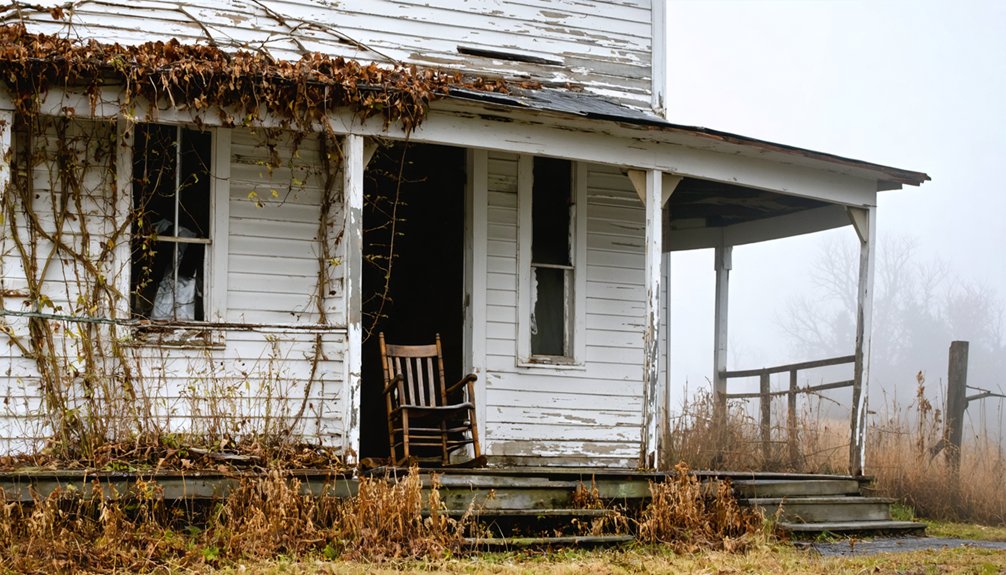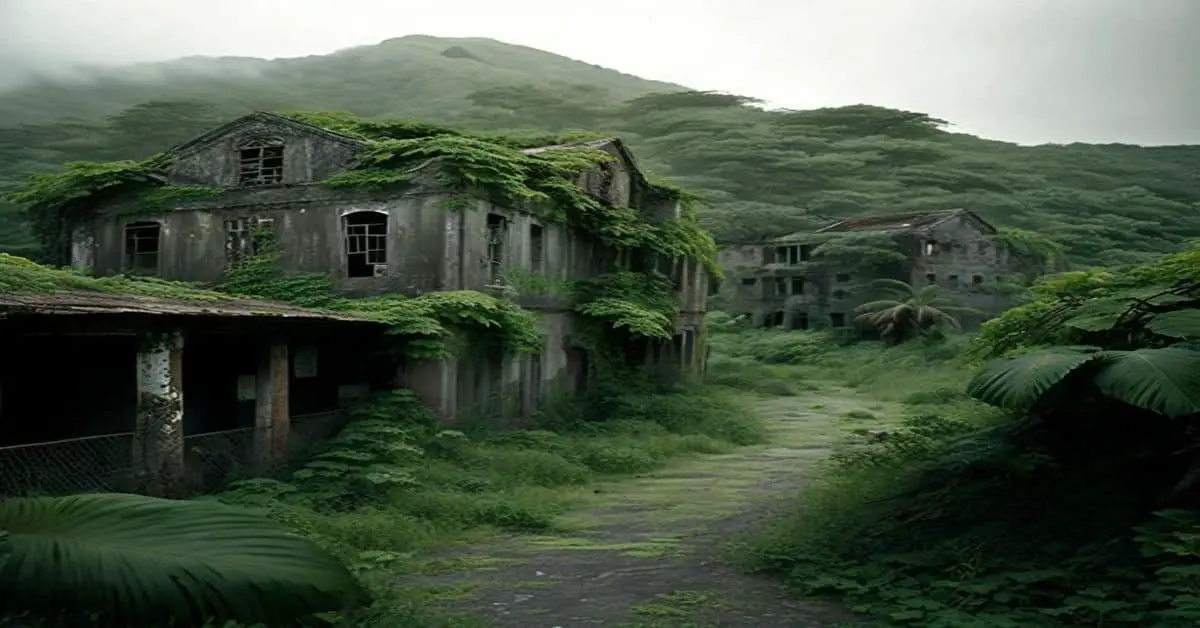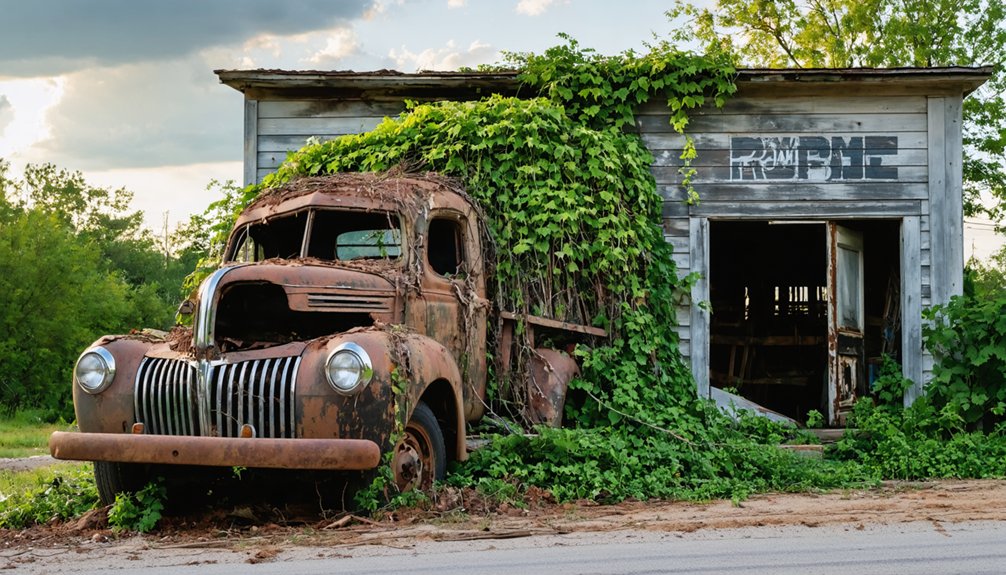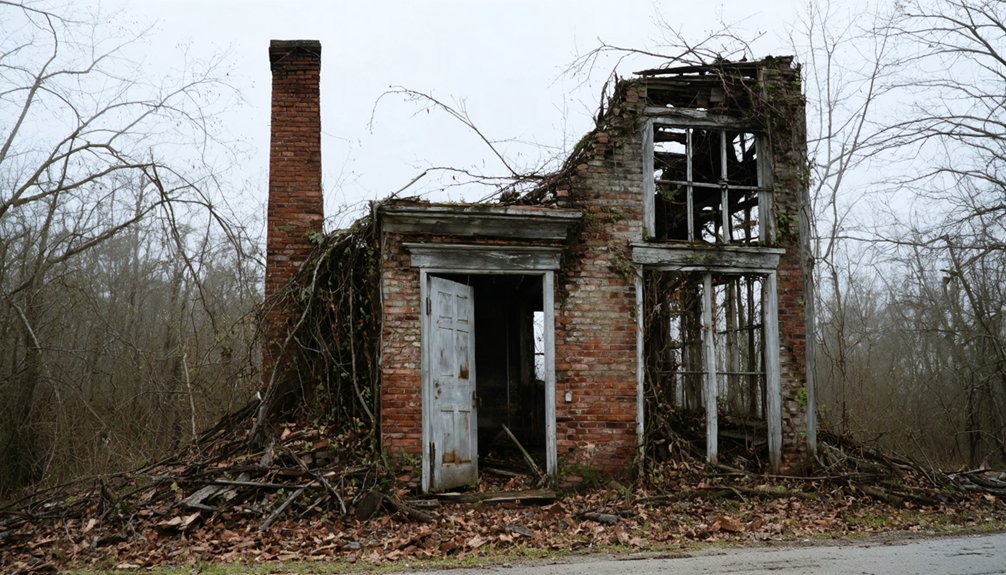You’ll find Washington, Alabama’s ghost town in Autauga County, where a bustling territorial capital once thrived. Founded in 1817 on the former Native American settlement of Atagi, the town grew to include a courthouse, hotel, jail, and post office. After losing its county seat status to Kingston in 1830, Washington declined swiftly, with its post office closing in 1854. Today, archaeological discoveries reveal fascinating details about daily life in this forgotten frontier settlement, where rich historical secrets await beneath the quiet fields.
Key Takeaways
- Washington, Alabama was founded in 1817 on the Autauga Indian settlement of Atagi and served as an early county seat.
- The town declined rapidly after losing its county seat status to Kingston in 1830, leading to widespread business closures.
- Archaeological evidence reveals the town’s layout through discoveries of courthouse foundations, ceramics, and daily life artifacts.
- The closure of Washington’s post office in 1854 marked the final stage of institutional withdrawal from the community.
- Today, the site maintains ghost town status with minimal preservation efforts and lacks organized tourism infrastructure.
The Rise of a Territorial Capital
When Mississippi achieved statehood in 1817, St. Stephens emerged as the capital of the newly formed Alabama Territory. You’ll find its strategic location atop a limestone bluff overlooking the Tombigbee River, about 67 miles north of Mobile, made it an ideal choice for territorial governance.
The town’s political significance soared as it hosted the first Territorial Assembly sessions in the Douglass Hotel. Similar to many Washington County districts across the United States, the area became a center of local governance and development. Judge Ephraim Kirby began establishing American legal authority in 1804.
The Douglass Hotel became a symbol of Alabama’s political birth, hosting landmark assembly meetings in the territorial capital.
Within just two years, St. Stephens transformed from a modest settlement into a bustling hub of several thousand residents. You’d have seen over 500 homes, twenty stores, two hotels, a theater, and even Alabama’s first chartered bank, the Tombeckbe Bank.
The assembly wasted no time establishing counties, drawing judicial districts, and preparing for the territory’s eventual statehood.
Economic Forces Behind the Decline
While Washington initially thrived as an essential administrative center, its economic downfall began with the devastating loss of its county seat status to Kingston in 1830. This sparked an economic migration as businesses, government functions, and residents relocated. The town’s decline mirrored challenges faced by other communities near Washington metropolitan area, which experienced significant population shifts during the same period. Much like Old Cahaba’s fate when it lost its position as state capital, Washington’s decline was swift and dramatic.
The commercial decline accelerated when Washington failed to secure railroad connections while competing towns modernized their transportation infrastructure.
- Loss of courthouse operations and public services triggered widespread business closures
- Absence of railroad access severely limited trade opportunities and economic growth
- River-based commerce diminished as neighboring towns developed better transport links
- Agricultural market shifts reduced demand for local goods and services
- Closure of the post office in 1854 signaled the final stage of institutional withdrawal
The compounding effects of these economic forces transformed a once-vibrant territorial capital into a ghost town by 1879.
Cultural Heritage and Local Legends
Beyond its economic decline, Washington’s rich cultural heritage began with its 1817 founding on the former Autauga Indian settlement of Atagi.
You’ll find its cultural significance deeply rooted in both Native American history and early Alabama settlement patterns, as evidenced by the town’s strategic selection as Autauga County’s first seat of government in 1819.
While local folklore remains sparse in documented form, the town’s connection to notable figures like Eugene Allen Smith adds depth to its historical narrative. Much like Old St. Stephens capital, Washington’s transformation into a ghost town remains shrouded in mystery.
The establishment of key institutions – a courthouse, hotel, jail, post office, and pillory – reflects the ambitious vision of early settlers.
Though Washington now stands as a ghost town with no remaining structures, its legacy lives on through its contribution to Autauga County’s development and its preservation of Native American heritage. The town’s courthouse once served as the setting for Judge Toulmin’s cases, where he maintained order in the wild frontier territory.
Archaeological Discoveries and Historical Sites
Recent archaeological investigations at Washington’s former court house site have revealed tantalizing clues about the ghost town’s physical layout and daily life.
Similar to findings at Old St. Stephens, the site has yielded valuable artifacts documenting Alabama’s territorial history.
You’ll find fascinating historical artifacts scattered throughout the area, from ceramic sherds to nails, that showcase the town’s archaeological significance during the mid-19th century.
- Test holes up to 10 inches wide uncovered evidence of the courthouse’s foundations and surrounding structures
- Surface collection yielded burned glass, pottery fragments, and other artifacts from daily life
- Historical sketch maps helped archaeologists pinpoint key building locations
- Probes confirmed the physical location of various lost structures
- The site’s preservation offers unique insights into Alabama’s territorial period
Self-guided tours are available daily for visitors to explore the archaeological discoveries.
The archaeological evidence paints a vivid picture of Washington’s bustling past, even though no standing structures remain today.
Modern Preservation and Tourism Impact
Unlike many preserved ghost towns across Alabama, Washington currently lacks formal preservation infrastructure and organized tourism initiatives.
You’ll find no visitor center, guided tours, or interpretive markers to help you understand this historic site’s significance. While the location maintains its official ghost town status in Autauga County, preservation challenges include minimal maintenance of remaining structures and absence of archaeological protection measures.
The site’s tourism potential remains largely untapped, with no dedicated facilities or organized activities to attract visitors. Unlike other Alabama attractions that offer comprehensive guide materials, Washington provides minimal resources for visitors to learn about its historical significance.
This stands in stark contrast to sites like Old Cahawba, where preserved ruins attract tourists seeking historical experiences.
You won’t find amenities like restrooms or picnic areas, and there’s limited economic benefit to the surrounding community. Local engagement is minimal, with no active preservation partnerships or community-led initiatives to share Washington’s story with future generations.
Frequently Asked Questions
Are There Any Documented Paranormal Activities in Washington’s Abandoned Buildings?
You’ll find limited verified ghost sightings in the buildings, with no formal paranormal investigations. While local stories mention haunted locations with unexplained lights and sounds, there’s no substantial documented evidence of activity.
What Happened to the Original Residents After They Left Washington?
You’ll find most original residents relocated to nearby growing towns and county seats, while others moved to plantations in the region, preserving their community legacy through social and family networks.
Can Visitors Legally Explore and Metal Detect in Washington?
You’ll need landowner permission and should check local metal detecting regulations. Since it’s a potential historical site, you must follow visitor guidelines and obtain necessary permits before exploring.
Were There Any Notable Crimes or Mysteries That Remained Unsolved?
Like shadows haunting empty streets, you’ll find Govan’s darkest secrets in two notorious unsolved murders: the 1902 Lewis family ax killings and the chilling 1941 mother-son murders that still puzzle investigators today.
What Valuable Artifacts From Washington Have Been Sold at Auctions?
You’ll find historic treasures like century-old glass pieces, mining tags, whiskey jugs, antique bottles, and lumber mill artifacts reaching significant auction prices. Native American relics and prosthetic parts also draw collectors.
References
- https://cla.auburn.edu/cah/programs/living-democracy/stories/savage-works-tirelessly-to-preserve-washington-county-history/
- http://www.themosttraveled.com/courthouse.html
- https://www.onlyinyourstate.com/experiences/alabama/alabama-ghost-towns
- https://digitalalabama.com/alabama-ghost-towns/alabama-ghost-towns/9449
- https://digitalalabama.com/article/alabama-ghost-towns/page/4
- https://en.wikipedia.org/wiki/List_of_ghost_towns_in_Alabama
- https://en.wikipedia.org/wiki/Washington_County
- https://encyclopediaofalabama.org/article/old-st-stephens/
- https://www.alabamalegacy.org/old-st-stephens/
- https://archives.alabama.gov/visit/exhibits/2017/st-stephens.aspx



